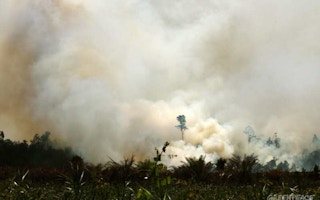The province of Riau in Sumatra, Indonesia has been covered in smog since early this week when the number of fire hotspots spiked at 488, the highest level in two months following Southeast Asia’s worst haze pollution in 16 years.
To continue reading, subscribe to Eco‑Business.
There's something for everyone. We offer a range of subscription plans.
- Access our stories and receive our Insights Weekly newsletter with the free EB Member plan.
- Unlock unlimited access to our content and archive with EB Circle.
- Publish your content with EB Premium.
The smoke, mostly contained in the provincial cities and districts, strained airport operations for the past two days. Flights had to veer away from Pekanbaru airport at the capital to avoid the thick blanket of air.
On the ground, visibility and public health were also impaired. Visibility was reduced to less than 500 metres while the smell of burning increased in intensity, forcing people to wear protective masks and schools to close.
The debilitating smog is a result of the continuing malpractice of slash-and-burn in the country, a method of clearing forests and peat lands for the cultivation of palm oil. Manufacturers have repeatedly denied this accusation, citing their zero-burning policies.
The haze, however, has become a regular occurrence through the years because of this unchecked practice, which is ingrained in the corruption in the foresty sector, according to Indonesia Corruption Watch chairman Danang Widoyoko, in a previous report.
As such, nearby nations Singapore and Malaysia have been frequent victims of the haze. Smoke from the deforestation is carried over by prevailing wind patterns.
Last June, in fact, winds blowing northward induced the most severe incident of haze pollution in the region in over a decade. Malaysia entered a state of emergency in certain areas of the country like Muar and Ledang, while in Singapore outdoor activities were grossly hampered, affecting business operations and the day-to-day lifestyles of residents.
With the latest forest fires and rise in number of hotspots, Singapore’s Minister for the Environment and Water Resources Vivian Balakrishnan called the situation “an exercise in frustration”.
Two months ago, the city-state had demanded a strong and effective action from the Indonesian government, asking them to identify the companies behind the illegal burning. So far, no companies have been held officially responsible.
Balakrishnan, resorting to Facebook on late Monday, wrote, “We remain at risk. Have to keep up the pressure on Indonesian authorities and companies to do the right thing for the sake of their own citizens and ours.”
Different agencies from the three countries were on alert to monitor the situation, particularly the wind direction and pollutant concentration of the smog.
In an advisory on Tueday, the National Environment Agency (NEA) of Singapore reported that a dense haze stretched over to the Strait of Malacca, a narrow strip of water between Sumatra and the Malay Peninsula.
Other than that, the closest location reported as a possible source of haze threat was a fire in Bintan, a small Indonesian island close to Singapore. Farmers were said to be burning land for cultivation, although this fire was not detected in the NEA satellite map.
As for Indonesia’s national disaster mitigation agency, spokesperson Sutopo Purwo Nugroho explained that the smoke posed no effect for Singapore and Malaysia at the moment since the wind was blowing northwest. “So it’s only spreading over Riau,” he added.
However, local weather analyst Warih Budi Lestari from the Pekanbaru meteorological, climatology and geophysics station, stated, “Based on our analysis, the wind in Riau is blowing from a southeast to southwest direction at a maximum speed of 30 kilometres per hour.” He said this direction leads to Malacca Strait, and should the wind pattern persist, it could affect Malaysia.
In the latest update from Singapore’s NEA on Wednesday, certain sections of Malaysia such as Penang and Kedah were said to have Air Pollutant Index levels in the unhealthy range. Singapore, on the other hand, “could still experience slightly hazy conditions” depending on the low level winds, the NEA added.
“But the occurrence of showers may have helped to subdue some of the hotspot activity,” said the agency.
In a statement to Eco-Business, Bustar Maitar, Greenpeace International’s head of the Indonesia Forest Campaign, said, “The wholesale clearing of land and development on peat land has created the conditions for this problem to recur again and again. Until companies break their link with forest destruction, and the government strengthens the moratorium on forest clearance and fully protect all peat land, then this will be a recurring nightmare for the people of Sumatra and the region.”








